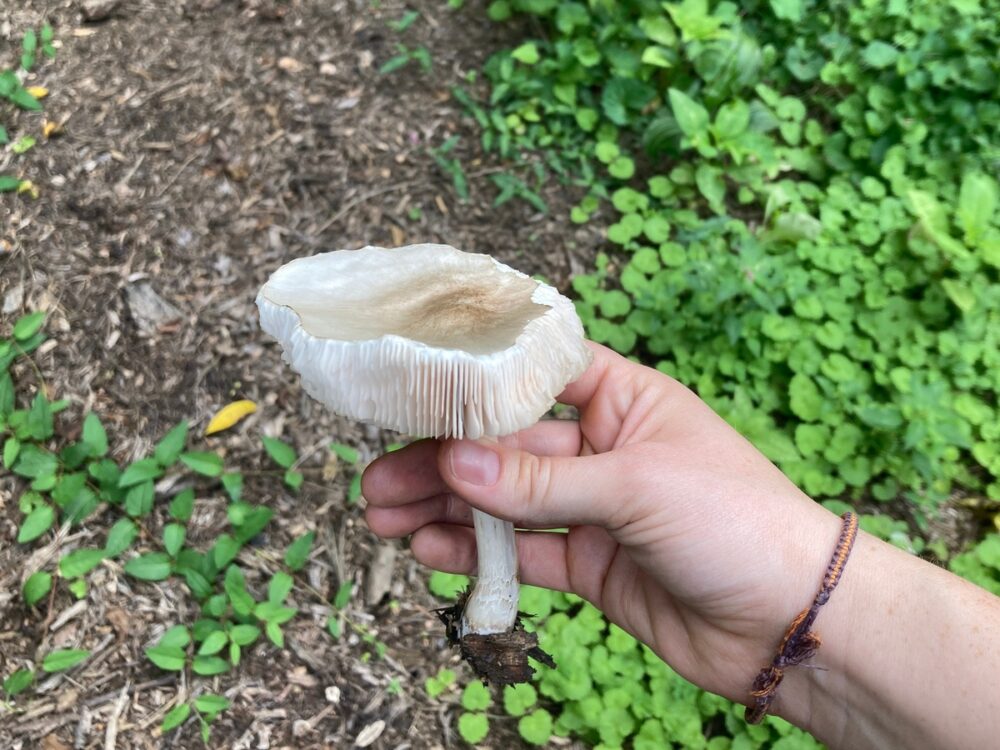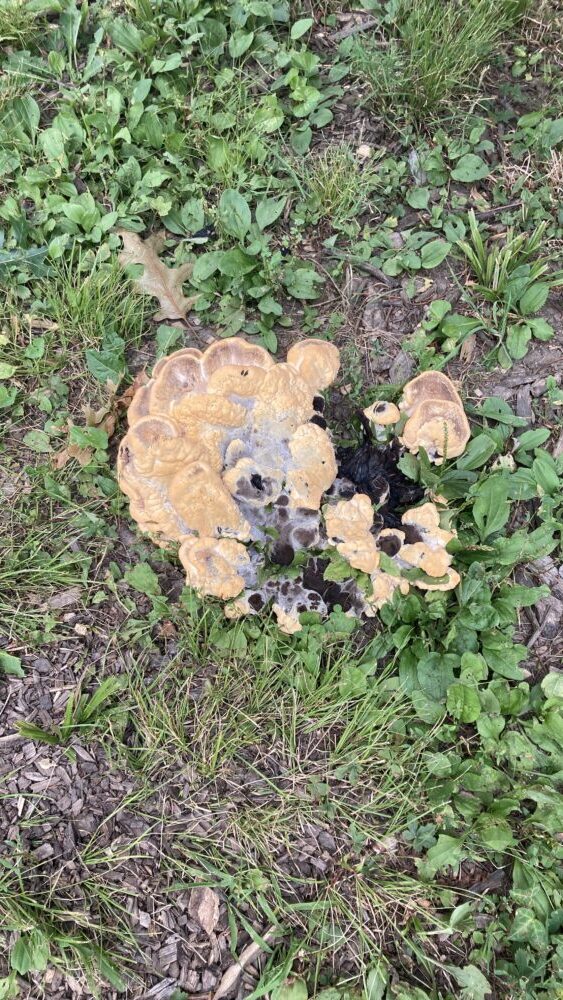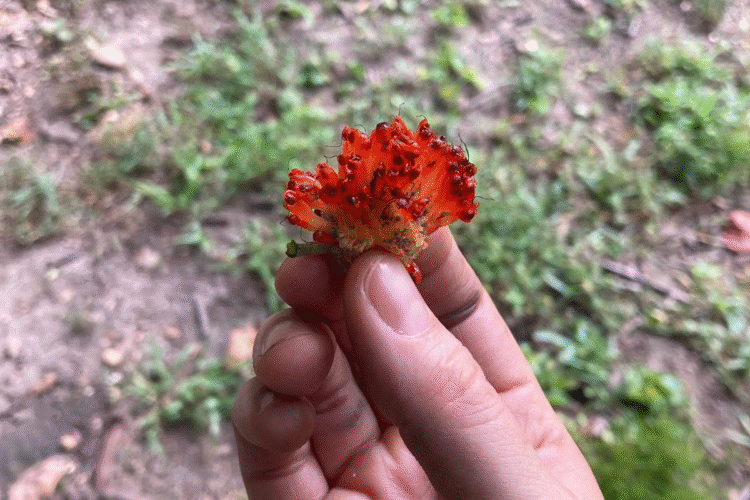
Can I eat that? Local mushroom enthusiasts answer foraging questions from taste to preserving biodiversity.
New to foraging? We took a walk with the Philadelphia Mycology Club to find out more about foraging locally.
Urban foraging may be on the rise. As consumers turn toward more budget-friendly plant-based meals and search for new ways to connect with their surroundings, finding food among the trees could be an increasingly popular option. Philadelphia has its own foraging resources, such as PHLASK and community clubs.
To help illuminate this growing field, Green Philly took a walk through a local park with Philadelphia Mycology Club founder Bethany Teigen and fellow club member, Jeremy Schwed. The Philadelphia Mycology Club is a fungi-focused non-profit that strives to provide free and accessible mushroom guidance through guided walks, workshops, social events, and trash clean-ups.
Interview edited for length and clarity.
Green Philly: Beth, first off, you say you don’t eat what you pick. Why is that?
Bethany Teigen: I’m just not really into the taste of mushrooms. That didn’t really have anything to do with me getting hooked on mushrooms.
GP: Jeremy, what are you carrying here?
Jeremy Schwed: This is just a fun [mushroom] that stains blue. It’s an oxidative reaction.
GP: What does oxidative mean?
Jeremy: It’s a reaction with the air. Part of the way to identify some mushrooms is that some of them will bruise in a different way. Some of them, the gills will bruise, and not the flesh, especially with a bolete, which is a type of mushroom with a cap, stem, and pores.
GP: Can I touch it?
Jeremy: One of the fun things about looking for mushrooms is that you can touch, play with, and even rip them apart.
Bethany: Here’s another edible one. Whoa. That’s a big guy.
GP: This one’s huge!

Bethany: This one can get a lot bigger, actually. It can really just take over a whole area. This is called Black staining polypore.
GP: What does it taste like?
Jeremy: Flavor-wise, there are a lot of different flavors of mushroom that you’ll find that are totally different from in the grocery store. There’s a lot that just tastes vaguely mushroomy, but some crazy ones out there, like the beefsteak fungus tastes like lemon.
Bethany: Oh yeah, the texture of the inside is really like a meat texture.
GP: Does that kind-of mess with your brain when you’re eating it?
Jeremy: It’s not really good in the things that you think it might be good in, and it’s intense by itself. So it’s not people’s favorite for eating.
GP: Is it okay if people come out here and start picking everything that they see?
Bethany: Great question. When you’re picking a mushroom, it is not the same as pulling a plant out of the ground. It’s more like picking a fruit off a plant; you know that plant was fine.
Not everything you do, however, while you pick mushrooms is sustainable. We tell people that we want to still think about the idea of Leave No Trace, aside from the fact that we’re obviously leaving a trace by picking a mushroom, but we would like to lessen that. A lot of foragers will talk about a “rule of thirds,” [in which you] only take a third of everything that you find.
Here’s another of the boletes that Jeremy had earlier. You can see this brown and pink now, but when it first hits the air– (She snaps off a piece of the cap).

GP: Oh, it turned blue so quickly! Sorry, I screamed that at you.
Bethany: No, everybody gets very excited when you first cut it. You can also taste some and spit it out.
GP: (taking a nibble) Should I spit it out?
Both Bethany and Jeremy: Yes.
Bethany: This is something important – when we say something’s edible, we usually mean after cooking. In general, when you’re eating something for the first time, you should eat a tiny bit and then wait 24 hours to see how you feel, because you don’t know if you’re allergic to it.
GP: If I walk down the street and see a serviceberry tree, can I pick it?
Bethany: As far as I know, there is nowhere in the city of Philadelphia that you are legally allowed to forage anything, other than on somebody’s private property that they gave you permission for. Another thing is the cleanliness of it. I’ve found many edible mushrooms on street trees in Center City and coming out of mulch in Fishtown. I’m a dog-walker, and I spend all day watching dogs pee on street plants.
Jeremy: You don’t want the down-low [specimens].
Bethany: If it was growing on the ground near a sidewalk, [some research shows] they absorb toxins from car exhaust. In terms of toxicity, being close to urbanization, like by a highway, you’re not really supposed to eat it. But those types of issues are cumulative rather than acute.
GP: Are there generally areas that are lower in risk for pesticides?
Bethany: The woods. If you’re in a green space, it’s probably fine, unless it’s a golf course or a lot of cemeteries.
Jeremy: Now that we’re a big club and bring a lot of people to the state parks, we have a pretty good relationship with those parks and have a scientific collection permit.

GP: What advice do you have for somebody who’s just starting to have an interest in foraging?
Bethany: Join a club. Just having somebody who can go out with you and point at something and tell you what it is is extremely useful, especially in terms of mushrooms versus plants. You need to talk to somebody who’s seen it a bunch of times if you’re gonna eat things.
Jeremy: It is good to start learning on your own; that helps you to know which things you want to investigate more. Then you can go to a club for more verification, which is what I started doing. I learned five basic beginner mushrooms, went and found a bunch of things in the woods that I thought looked like them, and then I found the [Mycology] club and posted stuff on Facebook, and they verified it for me.
GP: It sounds like this process of learning and being able to identify is more of a verbal history, or maybe is something that is passed down in person, rather than being able to access that through books.
Bethany: Yes. In terms of North American mycology, there are not many books. Plant-wise, there are plenty of books. Even the people who say that they’re self-taught – what they mean is, they took it upon themselves to ask other people a bunch of questions about mushrooms.
GP: What do you guys hope for in the future of this club and people foraging in Philly?
Bethany: We’re not here to teach people to forage – we are happy to – but what we’re here to do is attempt to conserve more green space and more diversity. We think the easiest way to do that is to get more people to care about what is in the woods.
I believe that holistic approaches are the only way to sustain them, and I think learning more about biodiversity is the only way to conserve them.
Note: The idea for this article was generated through conversations with community members during our Green Philly Pop-Up Newsroom at The Oval. Stay tuned for more pop-up-inspired stories, and email info@greenphl.com if you have any news tips to share.
Cover photo: Angie Bacha






